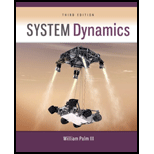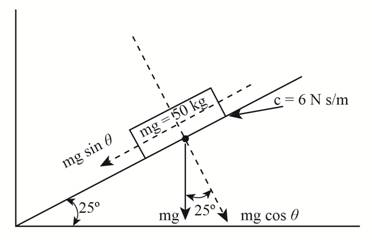
Concept explainers
(a)
The equation of motion for the system.
Answer to Problem 4.50P
The equation of motion for the system is
Explanation of Solution
Given information:
The mass of the block on an inclined plane is
Figure-(1) shows the

Figure-(1)
Here, the component of force acting in the horizontal direction along the inclined plane is
Write the expression for equation of motion for the system along the inclined plane.
Here, the force acting on the block is
Calculation:
Substitute
Conclusion:
The equation of motion for the system is
(b)
The equation of motion for speed
Answer to Problem 4.50P
The equation of motion for speed
Explanation of Solution
Given information:
The initial speed of the block is
Write the expression for equation of motion for the system.
Apply Laplace transform for Equation (IV)
Apply partial fraction technique for Equation (V).
Substitute
Equate coefficient on both sides of Equation
Substitute
Calculation:
Substitute
Substitute
Take inverse Laplace transform.
Conclusion:
The equation of motion for speed
(c)
The steady-state speed of the block
The time required to reach the speed.
Answer to Problem 4.50P
The steady-state speed of the block is
The time required to reach the speed
Explanation of Solution
Write the expression for first order differential equation along with dynamic value.
Here, the time constant is
Write the expression for time required to reach the steady-state speed
Here, the time required to reach the steady-state is
Calculation:
Compare Equation (IV) and Equation (VIII).
Substitute
Substitute
Conclusion:
The steady-state speed of the block is
The time required to reach the speed
(d)
The effect of initial velocity on the steady-state speed.
Explanation of Solution
Write the expression for steady-state speed.
Since the steady-state speed is zero therefore, the initial velocity is independent of the steady-state speed and hence, the initial velocity does not affect the steady-state speed value.
Conclusion:
The initial velocity does not affect the steady-state speed value.
Want to see more full solutions like this?
Chapter 4 Solutions
System Dynamics
- Law of Sines Solve the following problems using the Law of Sin 7. Find side x. All dimensions are in inches. -°-67°-37° 81° x Sin A 8.820 X 67°00' 32°00' a sin A b C sin B sin Carrow_forward35. a. Determine B. b. Determine side b. c. Determine side c. 5.330 in.- ZB 73°30'arrow_forwardConsider a 12 cm internal diameter, 14 m long circular duct whose interior surface is wet. The duct is to be dried by forcing dry air at 1 atm and 15 degrees C throught it at an average velocity of 3m/s. The duct passes through a chilled roo, and it remains at an average temp of 15 degrees C at all time. Determine the mass transfer coeeficient in the duct.arrow_forward
- 1. Calculation Calculate the DOF of the following mechanis m 2 3 1 Please enter the answerarrow_forwarda) Determine state of stress at all points (a, b and c). These points are located on the exteriorsurface of the beam. Point a is located along the centreline of the beam, point b is 15mmfrom the centreline and point c is located on the edge of the beam. Present yourresults in a table and ensure that your sign convention is clearly shownb) Construct Mohrs circle at this point andcalculate the principal stresses and maximum in‐plane shear stress (τmax) at pointc. sketch the resulting state of stress at this point clearly indicating themagnitude of the stresses and any angles associated with the state of stress (principal ormaximum in‐plane shear).arrow_forwardparts e,f,garrow_forward
 Elements Of ElectromagneticsMechanical EngineeringISBN:9780190698614Author:Sadiku, Matthew N. O.Publisher:Oxford University Press
Elements Of ElectromagneticsMechanical EngineeringISBN:9780190698614Author:Sadiku, Matthew N. O.Publisher:Oxford University Press Mechanics of Materials (10th Edition)Mechanical EngineeringISBN:9780134319650Author:Russell C. HibbelerPublisher:PEARSON
Mechanics of Materials (10th Edition)Mechanical EngineeringISBN:9780134319650Author:Russell C. HibbelerPublisher:PEARSON Thermodynamics: An Engineering ApproachMechanical EngineeringISBN:9781259822674Author:Yunus A. Cengel Dr., Michael A. BolesPublisher:McGraw-Hill Education
Thermodynamics: An Engineering ApproachMechanical EngineeringISBN:9781259822674Author:Yunus A. Cengel Dr., Michael A. BolesPublisher:McGraw-Hill Education Control Systems EngineeringMechanical EngineeringISBN:9781118170519Author:Norman S. NisePublisher:WILEY
Control Systems EngineeringMechanical EngineeringISBN:9781118170519Author:Norman S. NisePublisher:WILEY Mechanics of Materials (MindTap Course List)Mechanical EngineeringISBN:9781337093347Author:Barry J. Goodno, James M. GerePublisher:Cengage Learning
Mechanics of Materials (MindTap Course List)Mechanical EngineeringISBN:9781337093347Author:Barry J. Goodno, James M. GerePublisher:Cengage Learning Engineering Mechanics: StaticsMechanical EngineeringISBN:9781118807330Author:James L. Meriam, L. G. Kraige, J. N. BoltonPublisher:WILEY
Engineering Mechanics: StaticsMechanical EngineeringISBN:9781118807330Author:James L. Meriam, L. G. Kraige, J. N. BoltonPublisher:WILEY





